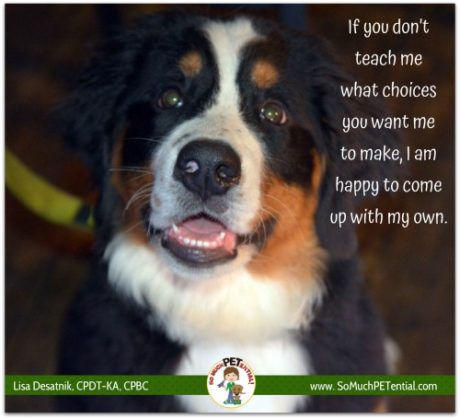When you ask your dog to sit or lay down, does it ever immediately pop back up into a stand instead of stay in position? And, what happens when you are out for a walk and stop to talk to someone? Does your dog go exploring and begin to pull on the leash when you’d like it to simply sit by your side?
 It is easy to get frustrated when your dog does not do what you want, but we have to remember, pets are not mind readers. If we do not teach them what it is we want them to do in any given situation, they are likely to come up with their own choice that is based upon where the value is for them. Anytime they are doing something, they are doing what works for them in the moment to get something of value or avoid something aversive.
It is easy to get frustrated when your dog does not do what you want, but we have to remember, pets are not mind readers. If we do not teach them what it is we want them to do in any given situation, they are likely to come up with their own choice that is based upon where the value is for them. Anytime they are doing something, they are doing what works for them in the moment to get something of value or avoid something aversive.
So, let’s talk about several points here as it relates to the human factor in training.
Your Role in Paying Attention
People tend to think about focus as it relates to their students. It is one of the reasons why short training sessions are best and why you are helping your pet to succeed when you train in an environment with limited distractions, or a distraction level in which your animal is still motivated and able to maintain its attention on the lesson at hand.
But you should not leave yourself out of this consideration. Anytime you are training, you need to be completely attentive to your student and your lesson. If a distraction occurs during training (such as the phone ringing or your wanting to talk to someone), take a pause. If you are just beginning to teach stay and your dog doesn’t yet understand the concept, release your dog before turning your attention to something else so you do not set it up for failure.
Clarity
Remember, it is very difficult for an animal who doesn’t speak human to understand what we want them to do. When teaching, remember clear two-way communication is so important. Teach with small steps and great reinforcement for good choices. But also, remember that, if in ‘your mind’ you would like for your dog to sit at your side when you talk to someone while on a walk…that sitting by your side is a behavior YOU need to teach your dog, and reinforce it in that situation. Just as explained above, your focus needs to be on your dog’s behavior in that moment.
Realistic Expectations
If your pet continues to make unwanted choices, or if you ask your pet to do a behavior multiple times and your pet does something else, know that it is not because your pet is being dumb or obstinate. Instead, see it as a case of your student telling you it either needs much more positive practice of learning the behavior, or it is not motivated to stay focused in that moment. This is a time for you as the teacher to pause or stop the training and review what you need to change to help you both succeed the next time.
Watch what you are reinforcing
A common error I see among dog handlers is when their dog’s wanted behavior gets ignored and only its unwanted behavior gets attention. I have seen dogs sitting at their owners side quietly and getting zero reinforcement until the dog gets up and barks, at which point, the owner may yell (giving attention) and the dog gets self reinforcement in terms of adrenal and excitement. The owner may jerk the leash to get the dog to sit down but if the strength of the reinforcer overpowers the aversiveness of the stimulus, the pet will continue to choose to get up and bark. A better alternative is to concentrate on catching the wanted behavior and giving that behavior a lot of reinforcement.







